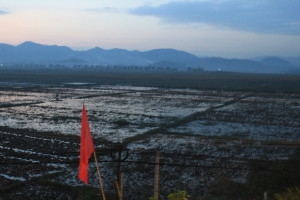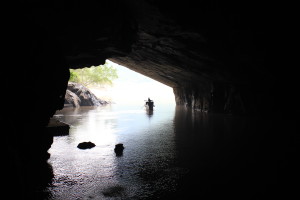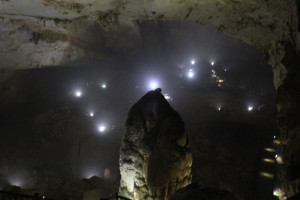 We are wrapping up three days on a Farmstay in Phong Nha which is located in central Vietnam, about 50k from Laos and a few hours drive to Da Nang and the ocean.
We are wrapping up three days on a Farmstay in Phong Nha which is located in central Vietnam, about 50k from Laos and a few hours drive to Da Nang and the ocean.
Watching the sunset over an ocean of paddie fields from our hammocks, roughing it with a Mojito, listening to the water buffalo groan on their walk home, I think back on the two experiences we had here and how they were so different from each other in the emotions yet provoked but so interconnected through the people who showed their mountain homes to us.
Phong Nha is a 80k long river cave that starts on a smaller branch of the main river which runs through this valley. Three British explored the entire length of the cave in the 90s but no one has made it trough since then. During the flood season the water can rise to 90 feet high in the cave which shockingly does not even come close to touching the ceiling. Some of the larger chambers can fit a 40 sorry building, or the Statue of Liberty inside without touching the roof.
We took a boat into the mouth of the cave, which is very large itself, an then climbed into a beach and entered several larger chambers where massive stalagmites and stalactites grew and dropped from the floor and ceiling. Some 30-40 feet high. All the mountains here are limestone remnants of the ocean that once covered Vietnam and their signature shape can be seen from Southern China to Southern Vietnam. Water slowly works through the cracks and creates some of the largest caves in the world here.
Recently a cave called Hang Son E was discovered here and was found to be the largest cave in the world in volume with whole Forrest living inside beneath sink holes of collapsed stone. People repel down into the 300 feet deep pits and spend days inside the dark exploring. Maybe next year!
Our second day took us on a tour of the Phong Nha national park which spans the border with Laos. Our guide had grown up here and his family has lived here for generations. It was on this tour that the trip became much more contemplative and often sad. The road we drove on was part of the Ho Chi Minh Trail during the war and for this reason was very heavily bombed during the final phase of the war under Nixon. Knowing that we were pulling our forces out shortly, we began a massive air campaign called Operation Linebacker, the same campaign I referenced in the Hanoi blog, which involved the greatest use of air bombardment in history. 600 tons of bombs were dropped from B52s per person in this area. Knowing that the HCM trail could not be located concretely, the planes were ordered to fly in lower that normal and bomb not only the fields but also the mountain in the hope of causing landslides which might block the road south or east into Laos. Because our bombs were developed for use in industrial Europe in WW2 they very often landed without exploding in the soft mud of the paddies and jungle. It’s estimated that 30% of all the bombs did not explode in this area of impact. Our guide told us of many his childhood friends who were killed either by stepping on bombs while watching buffalo in the fields or by picking up the small cluster bombs and playing with them causing them to explode. There have been some 10,000 post war deaths in the areas along the DMZ since the war to date. We saw a number of bomb shells stacked in front of homes and many cluster bombs piled up which have been pulled from the fields. The beautiful lakes we can look out at here are actually not naturally formed but are bomb craters which remain to be filled.
Phong Nha cave itself was a hospital during the war where they also hid a large pontoon bridge during the day. At night they would float it out and a convoy of trucks from Haiphong Harbor, carrying Soviet and Chinese weapons and diesel, would drive south towards the DMZ or into Laos. Once we found out about the cave we tried many times to get a direct hit into the cave with small jets with one successful hit. The cave is so deep and vast that it caused no damage but last year that American pilot actually came here and stayed at the farm where he talked with the farms owner, a woman who maned the AA guns shooting at him, On that same day. Must have been an interesting conversation to listen too. By the end of Operation Linebacker, 17 B52s had been shot down, little had been accomplished to disrupt the HCM trail.
War cemeteries are everywhere here and the incense burns non stop. We are invited in to pray and it is a surreal experience. While only 25% of our soldiers who faced combat here were drafted, despite the huge myth of disproportion that Hollywood had made us think, 100% of the people who lived here fought in the war and everyone has a story. They seem forever able to forgive and welcome us back to Vietnam. Maybe that comes from having driven out so many Monghols, Chinese, Japanese and French before us. Maybe it fosters a mentality of moving forward, of firmness in belief that only the Vietnamese with govern this land. I hope that perhaps the Afghanis will one day feel this way as their story is not so different than Vietnam’s. An endless stream of empires passing in and inevitably out of their lives.
Our stay here at the farm has been truly unique. Far off the beaten path, surrounds by water and rice, the sound of motorcycle and car horns replaces by the tranquil sounds of buffalo and cow in their perennial battle with the plow they are attached to. Children on bicycle ride by on muddy roads, immaculately dressed, and endless streams of attempts at, “hello, where are your from and Hi Five!” In the distance the long low profile of the fishing boats slide quietly upriver towards the moth of Phong Nha and the sun sets toward our destination.
The Perfume River and Hue lie waiting.


Speak Your Mind